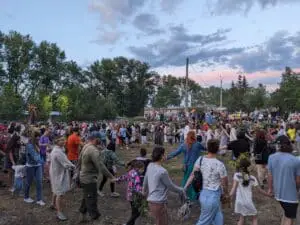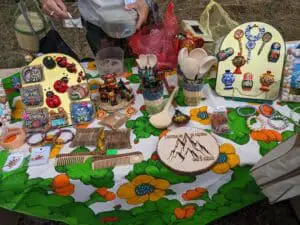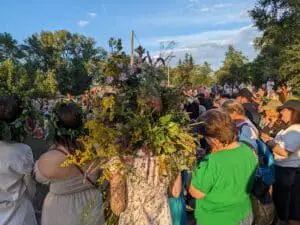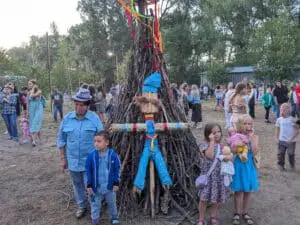In July 2023, as a volunteer on an ethnographic expedition studying the folklore of Old Believers in Eastern Kazakhstan, I was invited to attend and participate in the Ivan Kupala Day celebration. The holiday is a Slavic midsummer event, and this particular celebration is organized by the Russian Ethnographic Museum in Ust-Kamenogorsk, Kazakhstan. We attended on July 6 at the beautiful Left Bank Complex on the Irtysh River.
The Multi-Culturalism of Ust-Kamenogorsk in Kazakhstan
We began our experience with a guided tour of the park, where we were told that the city has a long history of multiculturalism. In fact, the city itself has two names – Ust-Kamenogorsk and Oskemen (the Kazakh name). Both are official, and they are often used interchangeably by those who live in the area. Kazakhstan recognizes both Russian and Kazakh as official languages on equal footing. Thus, it makes sense that the names would be interchangeable. However, if you purchase tickets to go here, they will most likely say Ust-Kamenogorsk and the Russian name was the one that everyone, including locals addressing out group, used when speaking with us. Thus, for clarity, this is the name I will use in this article.

Located just around 80 miles from the Russian border, Ust-Kamenogorsk has a long history of multiculturalism. It only recently became a Kazakh-majority city and Russians still make up about 45% of the population. The city is dotted with both mosques and Orthodox churches.
After learning about the history of the park and city, our guide took us to where the celebration would soon begin. Claiming our spots in the grass, I noticed that the crowd around us was a vibrant mix of people of all ages and backgrounds. Most of the group, the performers, and the organizers were Russian, but there were still many Kazakhs in the crowd. When speaking with them, many of them said they enjoyed attending the celebration every year. Despite the Slavic roots of Ivan Kupala Day, some Kazakhs are incorporating it into their culture in Ust-Kamenogorsk. Similar incorporations can be seen with the celebration of Maslenitsa in Kazakhstan and Kyrgyzstan, for example, and even with New Year Celebration, which was first brought to Central Asia in the 1800s by Russians and today stands as one of the largest as most important celebrations of the year.
Dances, Games and Crafts for Ivan Kupala in Kazakhstan
The festivities began with the arrival of groups wearing traditional Slavic sarafans performing conventional Slavic folk songs. Since these singers were local women from nearby villages who had learned these songs from their parents and grandparents, many themes came from Cossack folklore. The Cossacks came from southern Russian and Ukrainian peasants that sometimes served as mercenaries and garrison units for the Russian Empire. Thus, the lyrics these women beautifully sang often dealt with returning from war to find your family gone, spending many days on horseback, and living a life on the road. Even without understanding every word, the way these women sang took my breath away, and I could genuinely feel the emotion behind the song.
After the women had performed a few songs, the event organizers returned, announcing that the first set of dances would begin in a few moments. Once the music started playing, everyone stood up from their seats in the grass. The master of ceremonies instructed us to join hands with the people around us and form a circle. We then began to move in rhythm with the music and lyrics. For the next half hour, everyone participated in various circle dances, all intended to represent the movement of time and the seasons. According to the organizers, these rituals and dances were believed necessary for time to continue moving, as the sun would refuse to move into the next season if the dances did not occur. This circular year and the corresponding passage of time is still a crucial part of the folklore surrounding Ivan Kupala and other folklore today.
Once the dances were over, the folklore ensemble began singing. At the same time, the announcer instructed the children how to play traditional Slavic games, including ones explicitly meant for Ivan Kupala Day with circular movements and rhythmic chants. I made my way to the area where several people were selling handmade crafts, walking past a food cart selling corn, cotton candy, ice cream, and various sodas on my way. Interestingly, there was no other food available at the event itself, which was fairly long. Hard boiled eggs are often traditionally eaten for Ivan Kupala, as are dumplings (both symbolizing fertility). However, neither were available at the event.
The craft vendors were happy to tell you about their jewelry, dolls, crocheted items, wood-carved whistles, and souvenirs. After studying my options, I bought a crocheted Cheburashka, a famous Russian cartoon character, to bring back home for 900 tenge ($1.99).
Wreathmaking Competition
Now that the folklore ensemble had finished singing, it was time for the wreath-making competition to begin. The announcer invited any women who wanted to participate to head off into the outer reaches of the meadows and pick their flowers. Several dozen participants accepted the challenge, the younger ones racing after each other to get the most colorful flowers. After she had collected enough, each woman began to weave her wreath, placing it upon her head after completion. According to the tales people told at the festival, these wreaths hold one’s ancestors inside them. Before the conclusion of the Ivan Kupala Day festivities, each woman must throw their wreath into the river, or else forest nymphs will jump on their head, causing them to suffer from incredible headaches for the following year. This tradition, like many others, comes from the Slavic belief that Ivan Kupala Day is a threshold day, when the world is passing from time to another, and spirits are thus more active than usual, causing the connections between the living and the dead to become stronger. Midsummer is celebrated in many cultures as a threshold day – a concept that permeates nearly all cultures.
Once everyone had completed their wreaths, the women lined up before the crowd. Each introduced themselves while showing off the wreath that they had made. From tiny, neat wreaths to huge, flashy ones, various styles of wreaths stood on display. After all the participants had introduced themselves, the crowd chose a winner with their applause, and everyone celebrated together, taking pictures of the gorgeous wreaths.
Conclusion of Ivan Kupala: Fire and Water
After another round of circle dances, the sun began to slip behind the mountains. Everyone slowly started making their way toward the bonfire that had been prepared, eagerly anticipating the burning of the effigy. While the master of ceremonies explained that it symbolized the year’s harvest and must be burned for there to be a good harvest the following year, the effigy of straw was carried in and placed against the firewood. The effigy itself was dressed like a traditional Cossack man, including the strong mustache that they have often been associated with. People were allowed to come up and touch the effigy, with many also taking the chance to get a picture with it.
The event organizers then began to lead the crowd in a chant used during the lighting of the fire. As the crowd swayed back and forth, a man entered the circle with a torch. Despite initially struggling to start, the fire soon roared to life, bringing cheers and shouts from the crowd. Three men began to roll an axle with a large wooden wheel attached to it around the fire. The wheel, yet another representation of the circular year, caught flame itself, and the men continued to roll it until too much of it had burned away for it to continue moving.
As the fire enveloped the effigy, it burned away the previous season’s spirit and harvest, inviting the world to transition into the next season. Even with the various backgrounds and languages of everyone in attendance, everyone was united in this moment of awe as we took part in a tradition with roots that trace back over a thousand years.
Slowly, the fire began to tip over and fall, inviting yet another roar from the crowd. One by one, and sometimes two by two, people began to run at the fire and jump over the flames. According to traditional beliefs, individuals who jump over the fire are rewarded with strength and fertility, and couples who do so without letting go of each other’s hands are said to go on to have a long and joyful relationship. Each time someone would run up and jump, the crowd would cheer them on and congratulate them for their bravery. The fire eventually died out, and everyone went home after the women had thrown their wreaths into the river. Still, that night’s energy and good spirits lived on for several days for everyone there.
You’ll Also Love

Central Asian Culinary Discoveries
As an American having lived in Moscow for the past 12 years, I’m fairly well acquainted with Central Asian culture. Much of Central Asia was incorporated into the Russian Empire and was part of the USSR. Today, the majority of immigrants to Moscow come from Central Asia. Thus, finding examples of Central Asian cuisine, dress, […]
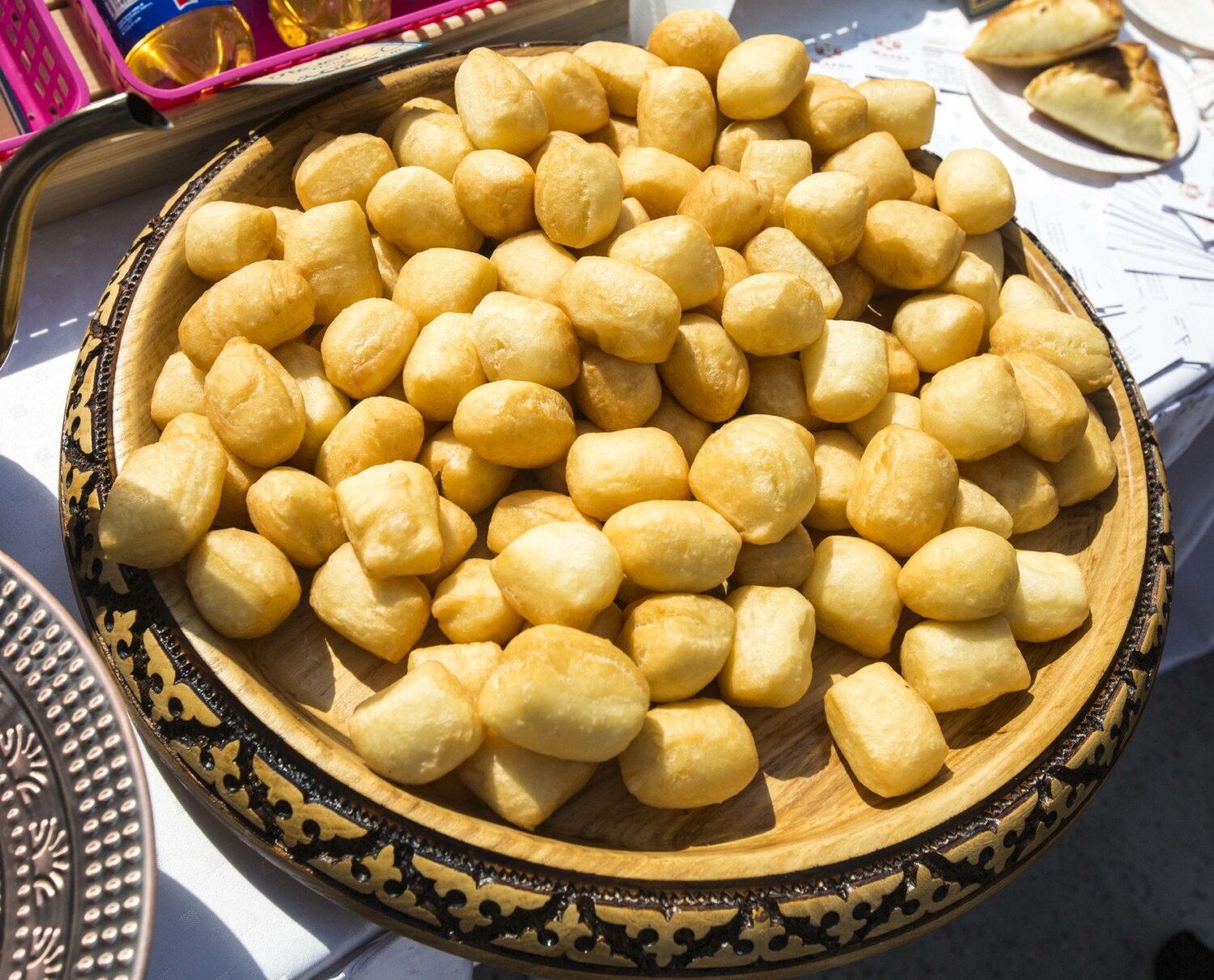
Baursak: The Donut of Hospitality
Throughout much of Central Asia, one type of bread stands out from all the rest – baursak (баурсак). These small pieces of fried dough are known throughout Central Asia among many of the Turkic and Mongolian-speaking peoples there. In Kazakhstan and Kyrgyzstan especially, they are served as everyday fare accompanied by tea and are staple […]

Oromo: Kyrgyz Food with Vegetarian Options
For those obsessed with all things pumpkin — pumpkin pie, pumpkin ice-cream, pumpkin-spice lattes — oromo (оромо) is sure to please. Oromo is a rolled, layered, steamed pastry that comes with various fillings (pumpkin being common and our favorite). It evokes everything we love about pumpkin season back home in the States. This main dish […]

Ivan Kupala as Celebrated in Kazakhstan in 2023
In July 2023, as a volunteer on an ethnographic expedition studying the folklore of Old Believers in Eastern Kazakhstan, I was invited to attend and participate in the Ivan Kupala Day celebration. The holiday is a Slavic midsummer event, and this particular celebration is organized by the Russian Ethnographic Museum in Ust-Kamenogorsk, Kazakhstan. We attended […]

Beshbarmak (Norin; Narin): The Rich, Meaty Pasta from Central Asia
Beshbarmak (Бешбармак) is a dish enjoyed throughout Central Asia as well as regions of Russia and China. It consists of boiled meat served on a bed of thick, flat noodles and covered in an onion sauce called tuzdyk (туздык). A meal both hearty and delicious, beshbarmak is particularly popular in Kazakhstan and Kyrgyzstan where it holds […]


